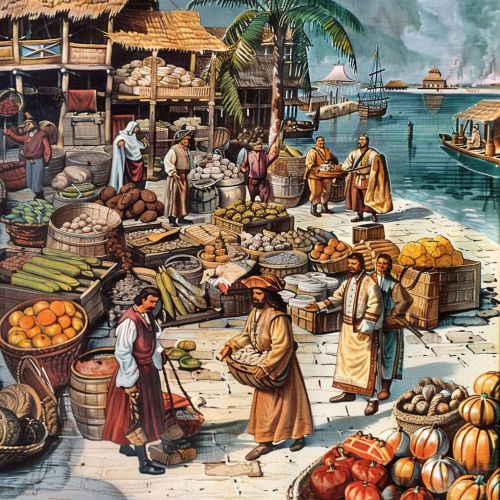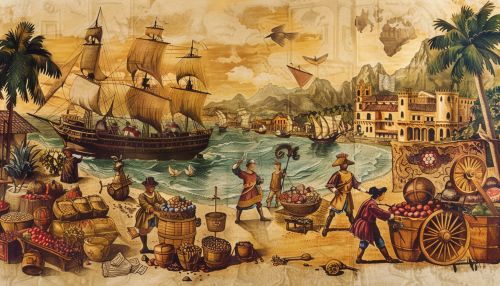Columbian Exchange
Introduction
The Columbian Exchange was a period of cultural and biological exchanges between the New and Old Worlds. Exchanges of plants, animals, diseases and technology transformed European and Native American ways of life. Beginning after Columbus' discovery in 1492, the exchange lasted throughout the years of expansion and discovery.


Biological Exchanges
The most immediate result of the Columbian Exchange was a dramatic biological swap between the two worlds. Two very different kinds of ecosystems came into contact and began to mix in ways that had never occurred before.
Flora
The New World provided many new plants to the Old World, including maize (or corn), potatoes, sweet potatoes, and manioc, which became staples in the Old World and helped to increase its population. Other New World crops, such as tomatoes, peppers, pumpkins, squash, beans, pineapple, cacao, vanilla, and tobacco, were also transferred.
Fauna
The Old World, for its part, sent a number of animals to the New World. Horses, cows, pigs, sheep, goats, and chickens were among the Old World animals that had the most significant impacts in the New World, as they often out-competed native species.
Cultural Exchanges
The Columbian Exchange also drastically increased the availability of many Old World crops and livestock in the Americas. Wheat, barley, rice, and turnips had all been unknown in the New World. Similarly, Old World livestock such as horses, cows, and pigs had been unknown to the Native Americans until Europeans brought them to the Americas.
Impact on Native Americans
The arrival of Europeans in the Americas brought about significant changes in Native American culture. The exchange of cultures and ideas was not always peaceful. The Europeans brought with them diseases like smallpox, measles, and influenza, which had devastating impacts on Native American populations.
Disease Exchange
One of the most significant effects of the Columbian Exchange was the exchange of diseases. Europeans brought deadly viral and bacterial diseases with them to the Americas, including smallpox, measles, mumps, whooping cough, influenza, chickenpox, and typhus. The Native American population was devastated by these diseases as they had no natural immunity.
Technological Exchanges
The Columbian Exchange was not only about the exchange of goods and diseases, but also technology. The Europeans brought with them new technologies like the wheel, iron tools, and weapons, which were quickly adopted by the Native Americans.
Conclusion
The Columbian Exchange was a significant event in human history that fundamentally changed the way life was lived on both sides of the Atlantic. The exchange of goods, ideas, and diseases shaped the modern world and remains a fascinating study in the interplay of culture, biology, and technology.
